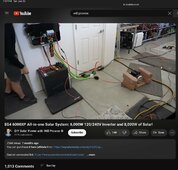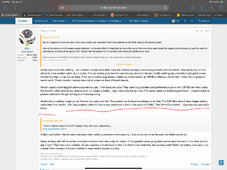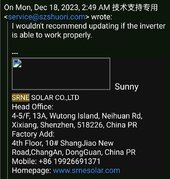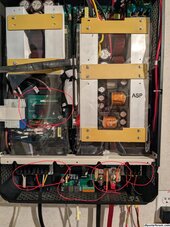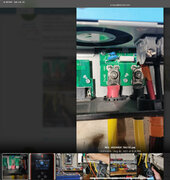Btw srne 10kW rated 20,000w max divide by ~51.2 is around ~390amps. I would think some of that is ac pass??? Think the max dc is ~ 220 amps - on SRNE ASP-10kW so am sure not going to pass muster 20kW but tiny time. Sound ~ Right? I think they sgp did the change in battery wire cable size based on that My Guess. The blue SRNE Asp- 8kW is recommending 3/0 battery cable by sgp and 4/0 for the 10kw. Blue sgp loves big cables.

With pv in the mix and way it is used messes with me. pV power production is crazy…..flux up and down.
Other systems Batteries and cables…Blue. Victron goes big on batteries and cables for surging too …their small 3000 and 5000 have huge cables.. Welding cable with small strands has a lot of parallel current carrying abilities. Victron uses cross section. Inverter Manufacturers are suppose to state breakers-fuse ratings that they recommend. Think UL portion.
With batteries:
Lifepo Battery cell small terminal contacts worry me ….. throw on small bus bar with slot for even more reduced contact area …measure bus bars -reduced…. whew. Wished in 20/20 hindsight had picked double bolt bus bar cells.


I am safe low power consumption and just want capacity run time. My highest energy peak in a year was around 9kW - emergency heat on heat pump. Reserve over head is nice but system all works as designed for personal expectations if a person knows what they are doing. Some Newbies don’t know. Public post must take considerations. Think you guys are doing good job sharing. Stay safe. Watched Will Prowse video and was dying - laughing when he jumped around corner of wall when testing an inverter.
My add I don’t think we should run inverters at max and expect them to last long. Basic logic gas power generators are recommended half loads or lower. Both for fuel ratings and from wave form degrading. We won’t mention UL gas generators vs not.

you guys going parallel with over head are going better route….imho…..
I think you guys doing the parallel setups and leaving head room is safe thing to do. It is nice to know they can be hammer time for a needed max event too. Ppl have to purchase and build system accordingly but how are the new ppl that have never been shocked learn?

The documentation needs to be above board for them. Be nice if it just worked out of the box too. Will Prowse would not have to say great components - crap software in video reviews. Be nice to see his opinion on this one.


Someone recommended a good thermal camera in another thread those are great tools. See the heat realize the point of loss. Phones had software using cameras in phone but did away with it.
Some software guru get to writing take a chance. Quality is an ongoing process with it. If SRNE takes that to next level they will do huge volume take over. Their volume sales might take over now - so many different labels.
How do you upgrade software …. where or who is the support contact with SRNE? 1 of the 5kW relabel versions stated to make sure software matched with version . It did not say how to resolve. My MPP inverter documentation states the same. No real indicated resolve - imagine contact MPP. That process and web link should be easy to find…but that is not the case. Sadly most inverter companies are that way with software. Reading forums EG4 goes in and does remote software access updates to which I don’t like .

Email:
Watching Will Prowse load test EG4 6000xp was pure comedy to me for that scene.
